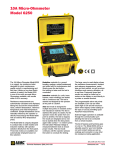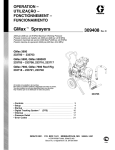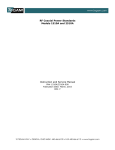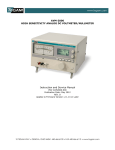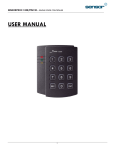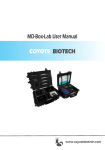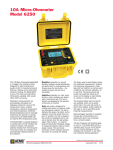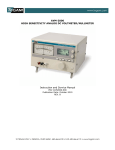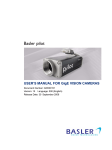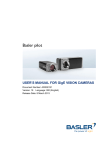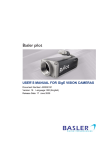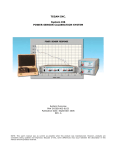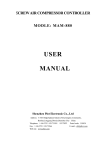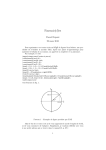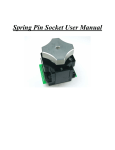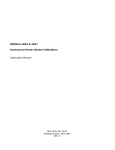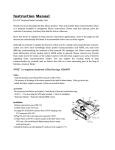Download Digital Thermometers Instruction Manual MODELS 868 and
Transcript
110A Digital Thermometers Instruction Manual MODELS 868 and 869 Instruction Manual PN# 869-901-01CD Publication Date: March 2011 REV. F NOTE: This User’s Manual was as current as possible when this product was manufactured. However, products are constantly being updated and improved. To ensure you have the latest documentation, refer to www.tegam.com 110A SPECIFICATIONS ............................................................................................................................................................................ 1 GENERAL INFORMATION .............................................................................................................................................................. 3 MANUAL ADDENDA ...................................................................................................................................................................... 3 OPTIONAL ACCESSORIES............................................................................................................................................................... 3 PREPARATION FOR USE ................................................................................................................................................................ 4 BATTERY INSTALLATION/REPLACEMENT...................................................................................................................................... 5 OPERATION ................................................................................................................................................................................... 6 SAFETY SYMBOLS AND TERMS ..................................................................................................................................................... 9 VERIFICATION PROCEDURE ........................................................................................................................................................10 CALIBRATION ..............................................................................................................................................................................12 GENERAL INSTRUMENT CALIBRATION .......................................................................................................................................13 Warranty .....................................................................................................................................................................................15 Warranty Limitations ..................................................................................................................................................................15 Statement of Calibration ............................................................................................................................................................15 110A SPECIFICATIONS MODEL 868 SPECIFICATIONS TEMPERATURE SENSOR TYPE: 3 wire or 4 wire 100 Ohm Platinum RTD (alpha = 0.00385). 4 WIRE TEMPERATURE ACCURACY* RANGE SPAN RESOLUTION (65° to 82°F; 1 Year) 200°F -100.0° to 199.9° 0.1° ±0.4°F -199.9° to -100.1° 0.1° ±1.0°F 1100°F -100° to 1100° 1° ±2°F -360° to -101° 1° ±4°F *ACCURACY: Includes DIN 43 760 (ITS-90) conformity, repeatability, temperature coefficient (65° to 82°F), time stability (1 year) and errors with up to 50 ohms of lead resistance (each lead). Excludes probe errors; however probe errors around 32°F may be compensated by an internal adjustment. REPEATABILITY: 0.2°F typical for 1 week at constant ambient temperature. TEMPERATURE COEFFICIENT: 65° to 82°F; included in accuracy specification. From 14° to 65° and 82° to 122°F: less than ±0.015°F/°F. MAXIMUM LEAD RESISTANCE (each lead): 4 Wire; 50 ohms 3 Wire; 10 ohms SENSOR CURRENT:500µA maximum. MODEL 869 SPECIFICATIONS TEMPERATURE SENSOR TYPE: 3 wire or 4 wire 100 Ohm Platinum RTD (alpha = 0.00385). 4 WIRE TEMPERATURE ACCURACY* RANGE SPAN RESOLUTION (18°to 28°C;1 Year) 200°C -100.0° to 199.9° 0.1° ±0.3°C -199.9° to -100.1° 0.1° ±1.5°C 630°C -100° to 630° 1° ±1°C -220° to -101° 1° ±2°C *ACCURACY: Includes DIN 43 760 (ITS-90) conformity, repeatabilitiy, temperature coefficient (18° to 28°C), time stability (1 year) and errors with up to 50 ohms of lead resistance (each lead). Excludes probe errors; however probe errors around 0°C may be compensated by an internal adjustment. REPEATABILITY: 0.1°C typical for 1 week at constant ambient temperature. TEMPERATURE COEFFICIENT: 18° to 28°C; included in accuracy specification. From -10° to 18° and 28° to 50°C: less than ±0.015°C/°C. MAXIMUM LEAD RESISTANCE (each lead): 4 Wire: 50 ohms 3 Wire; 10 ohms SENSOR CURRENT: 500µA maximum. MODEL 868 and 869 GENERAL SPECIFICATIONS (unless specified): DISPLAY: 3 1/2-digit LCD, 13mm (0.5") height. Polarity and decimal point indication. CONVERSION RATE: 1.5 readings per second. OVERRANGE AND OPEN SENSOR INDICATION: 3 least significant digits blanked. 1 110A MAXIMUM COMMON MODE VOLTAGE: 30VDC (42V peak AC). COMMON MODE REJECTION: Less than 0.001°/ volt at DC, 50 Hz and 60 Hz. (100Ω unblance, LO driven) ENVIRONMENTAL LIMITS FOR OPERATING: -10° to 50°C (14° to 122°F), less than 80% relative humidity up to 35°C (95°F). Reduce R.H. Limit by 3% from 35° to 50°C (1.7% R.H./°F from 95° to 122°F). ENVIRONMENTAL LIMITS FOR STORAGE: -35° to 60°C (-30° to 140°F), less than 90% relative humidity up to 35°C (95°F); Reduce R.H. Limit by 3%/°C from 35° to 60°C (1.7% R.H./°F from 95° to 140°F). INPUT CONNECTION: 4 pin miniature instrumentation connector. POWER: 9V alkaline or carbon-zinc battery. BATTERY LIFE, CONTINUOUS: 500 hours typical with alkaline battery; 300 hours typical with carbon-zinc battery. BATTERY INDICATOR: Display indicates "LO BAT' when less than 10% of life remains. DIMENSIONS, WEIGHT: 160mm long x 69mm wide x 31mm thick (6.3" x 2.7" x 1.2"). Net weight 210gm (7.5 oz.) CONSTRUCTION: Heavy duty ABS plastic housing. ACCESSORIES SUPPLIED: Battery, instruction manual and mating input connector. Specifications subject to change without notice. 2 110A GENERAL INFORMATION The TEGAM Models 868 and 869 are handheld digital thermometers designed to use 100Ω platinum RTD temperature sensors for high accuracy and long term temperature stability. The Model 868 has two switch-selectable ranges: from -199.9°F to + 199.9°F with 0.1°F resolution, and between -360°F and +1100° with 1°F resolution. The Model 869 measures between -199.9°C and + 199.9°C with 0.1°C resolution, or between -220°C and +630°C with 1°C resolution, or between -220°C and +630°C with 1°C resolution. Both instruments are designed for use with probes conforming to the DIN 43 760 standard. Model 868 and 869 features include: 1. Platinum RTD Based Temperature Measurements. A chief advantage of the platinum RTD (resistance temperature detector) sensor used by the unit is platinum's predictable resistance change with temperature, resulting in high accuracy. 2. Easily selected 3- or 4-Wire Measurements. The unit may be used with either 3-wire or 4-wire temperature probes. An internal jumper provides a means of easy 3- or 4wire selection (the unit is set for 4-wire operation at the factory). 3. Rugged Case. The instrument's case is made of high impact ABS plastic. 4. Long Battery Life. Because of low power consumption, an alkaline battery will typically last for 500 hours of continous operation. MANUAL ADDENDA Information presented in this manual was believed to be accurate at the time of printing. Any changes in the instrument, which occur after this manual is printed, will be covered separately in an addendum packed with the instrument. Be sure to note these changes before attempting to operate or service the instrument. OPTIONAL ACCESSORIES Available accessories, including recommended temperature probes, are listed below. Contact any TEGAM Distributor or the factory for information on purchasing accessories. 3 110A Model 8660 Tilt Stand/Belt Clip provides a convenient method of elevating the instrument to a convenient viewing height. The Model 8660 also includes a belt clip. Model 8668 Soft Carrying Case provides protection for the Model 868 or 869 during transportation or storage. Model 8693 General Purpose Immersion Probe is a 4-wire 100Ω platinum RTD probe designed for immersion in liquids as well as other general purpose applications. The Model 8693 has a basic tolerance of ±0.3°C at 0°C. The measurement range of the Model 8693 is -220°C to +630°C. Model 8695A Surface Probe is a 4-wire 100Ω platinum RTD probe designed to measure flat surfaces of solids in the range of -50°C to +260°C. The Model 8695A has a basic tolerance of ±0.3°C at 0°C. Model 8696 Air/Gas Probe is a 4-wire 10012 platinum RTD probe with an exposed sensor with an exposed sensor within a protective shroud to measure ambient temperature.The Model 8696 measures between -50°C and +260°C. The basic tolerance of the Model 8696 is ±0.3°C at 0°C. PREPARATION FOR USE Carefully unpack the instrument from its shipping carton and inspect for any obvious signs of physical damage. Report any damage to the shipping agent at once. The following items are included with every shipment: 1. Digital Thermometer 2. CD of Manual 3. 9V battery 4. 4-wire miniature instrumentation connector (mates with probe connector on the instrument). NOTE: As shipped, the instrument is configured for 4-wire probes. See the operation section for selection of 3-wire operation. 4 110A BATTERY INSTALLATION/REPLACEMENT A 9V battery is supplied with the unit. To install or replace the battery, proceed as follows: WARNING Turn off the power and disconnect the temperature probe before removing the back cover to install or replace the battery. Replace the back cover before resuming use of the instrument. 1. Place the unit face down on a cloth-covered flat surface. 2. Remove the screws in the back cover; now remove the back cover by carefully separating the two halves at the top of the instrument. 3. Place the 9V battery in the battery compartment as indicated in Figure 3, on page 7. Be sure to observe proper polarity. 4. Re-install the rear cover on the instrument. Make sure the two case halves line up properly; now secure the rear cover with the screws that were removed earlier. 5 110A OPERATION Figure 1 shows the general control layout, including display nomenclature, for your digital thermometer. The following paragraphs contain information on probe connection, 3- and 4-wire selection, range selection, and basic temperature measuring procedures. Probe Input Connector Low Battery Indicator Shows when less than 10% of battery Minus Sign Indicates Negative Temperature 1999 Count Display (Overrange indicated by “1” followed by blanked digits) ON-OFF/Range Switch Model 868 Model 869 Figure 1. Control and Display Nomenclature 1. Connect a temperature probe to the input connector on the top of the instrument. Use one of the probes described in the accessories section; or install a 4-wire connector on any 100 ohm platinum RTD probe using the information in Figure 2. 2. Make sure the instrument is set for 3-wire or 4-wire operation according to probe type in use. The unit is set for 4-wire operation at the factory, but the mode of operation may be changed as follows: A. Remove the rear cover as described in the Battery Installation/Replacement section of this manual. B. Place the 3-wire/4-wire jumper (see Figure 3) in the desired position. 6 110A C. Re-install the rear cover and tighten the retaining screws. REAR VIEW REAR VIEW Figure 2. 100 Ohm Platinum RTD Connections Pin 1 Source + Pin 2 Sense + Pin 3 Source - Pin 4 Sense - NOTE Use only 100Ω platinum RTD sensors that conform to the DIN 43 760 standard (alpha=0.00385). Other type sensors will give inaccurate results. Maximum allowable lead resistance for rated accuracy is 50Ω per lead (4-wire) or 10Ω per lead (3-wire). SWITCH COVER R103 R104 R105 BATTERY 4- WIRE 3 WIRE 4 WIRE JUMPER 3- WIRE Figure 3. 3-Wire/4-Wire Jumper Location NOTE For best accuracy, it is recommended that the instrument be used in the 4-wire configuration with a suitable 4-wire probe. If 3-wire probes are used with the instrument in the 4-wire mode, noisy readings will result (the displayed reading will jump around). Unlike 4-wire, 3-wire reading accuracy is affected by changes in lead resistance, and unbalanced lead wire resistance. 7 110A 3. Place the temperature range switch in the desired position. Use the lower range, when possible, for best resolution and accuracy. Power is automatically turned on when the range is selected. 4. Place the probe tip on or in the material to be measured. WARNING Do not subject the probe to a voltage more than 30V RMS, 42V peak above earth ground, or a shock hazard may result. 5. Take the reading from the display. The reading is in °F (Model 868) or °C (Model 869). A leading minus sign indicates a negative temperature reading. An over range a "1" followed by blanked digits) may indicate the need to switch to a higher range, or show that the temperature is outside the measuring range of the instrument, or that the probe is open. 6. When the measurement is complete, place the on-off/range switch in the OFF position to conserve the battery. ACCURACY CONSIDERATION Model 868 basic accuracy is specified as on page 1. Similarily, Model 869 basic accuracy is also specified on page 1. Keep in mind that these accuracy figures are for 4-wire probe operation with a lead resistance of less than 50Ω (each lead). Thus, 4-wire probes should be used, whenever possible, to maintain the highest accuracy. Accurate readings can also be made with the instrument in the 3-wire mode with a suitable 3-wire probe. For best accuracy, however, lead resistance should be no more than 10Ω per lead. Also, readings made in the 3-wire mode are sensitive to variations caused by changes in lead resistance as well as to differences in lead resistance. For example, a difference of only 38mΩ (0.038Ω) in lead resistance will cause a change of 0.1 °C around 0°C. Four-wire readings are not affected by these lead resistance variations. Accuracy figures do not include possible probe errors, which could affect overall measurement accuracy. Probe errors near 32°F for the Model 868, and near 0°C for the Model 869, can be minimized by recalibrating the instrument for use with a specific probe. For probe calibration procedures, refer to the calibration section of this manual. 8 110A The operating temperature of the instrument itself can affect accuracy. The accuracy figures given above are for an instrument operating in the range of 18°C to 28°C (65°F to 82°F). For operating environments between -10°C and 18°C (14°F and 65°F) and between 28°C and 50°C (82°F and 122°F), a temperature coefficient of less than ±0.015°C/°C (±0.015°F/°F) can be expected. SAFETY SYMBOLS AND TERMS The symbol ! on the instrument denotes that the user should refer to the operating instructions. The WARNING used in this manual explains dangers that should result in personal injury or death. The CAUTION used in this manual explains hazards that could damage the instrument. WARNING A shock hazard exists on the Instrument's input terminals when probes or sensors are exposed to voltage levels greater than 30V rms or 42V peak. 9 110A WARNING The information in this section is intended only for qualified service personnel. Before removing the back cover to service the instrument, disconnect the temperature probe. VERIFICATION PROCEDURE Performance verification is performed by connecting known, precise resistors to the instrument in place of a temperature probe and checking to see that the displayed reading falls within a prescribed range. The following procedure should be performed at an ambient temperature between 18°C and 28°C (65°F and 82°F) at a relative humidity of less than 80%. If the instrument has been stored outside these limits, allow at least 24 hours for operating conditions to stabilize. Required Equipment: Precision decade resistance, ±0.01% tolerance (Gen Rad Model 1433T or equivalent) Female 4-wire instrumentation connector (supplied with instrument). NOTE The following procedure must be performed with the instrument in the 4-wire mode. See Figure 3 for the location of the 3-wire/4-wire jumper which sets the appropriate mode. Access to the jumper requires rear cover removal as described in the disassembly instructions. Procedure: 1. Connect the precision resistance box to the instrumentation connector as shown in Figure 4. Plug the connector into the instrument. 2. Turn on the instrument and verify that the LO BAT indicator is not displayed; if it is, replace the battery before beginning the verification procedure. 10 110A REAR VIEW Figure 4. Connections for Performance Verification and Calibration 3. Refer to Table 1, which lists the verification procedure for both instruments covered by this manual. To verify instrument performance at each of the points, set the resistance box to the required value; with the instrument on the prescribed range, verify that the displayed reading falls within the necessary limits. 4. If the displayed reading is out of tolerance at any of the points, refer to the calibration section for the correct procedure to bring the instrument within tolerance. NOTE If the instrument is still under warranty (less than 12 months since the date of shipment), and it does not meet specifications after calibration, contact your TEGAM Distributor or the factory to determine the correct course of action. Table 1. Performance Verification Procedure Model 868 Range Resistance Value Allowable Reading (65°F to 82°F) 1100°F 10.81 Ω -364 to -356 200°F 71.00 Ω -100.4 to -99.6 200°F 93.03 Ω -0.4 to +0.4 200°F 114.68 Ω 99.6 to 100.4 200°F 134.92 Ω 194.6 to 195.4 1100°F 311.56 Ω 1098 to 1102 11 110A Table 1. Performance Verification Procedure (Cont.) Model 869 Range Resistance Value Allowable Reading (65°F to 82°F) 630°C 9.90 Ω -222 to -218 200°C 60.26 Ω -100.3 to -99.7 200°C 100.00 Ω -0.3 to +0.3 200°C 138.51 Ω 99.7 to 100.3 200°C 174.01 Ω 194.7 to 195.3 630°C 313.71 Ω 599 to 601 CALIBRATION Calibration should be performed yearly or whenever the instrument is known to be out of specification. Calibration should be done at an ambient temperature of 23±1 °C at a relative humidity of less than 80%. Normal instrument calibration is performed by substituting precision resistors of known value for the temperature probe and adjusting calibration potentiometers for specified readings on the display. The instrument may also be calibrated to compensate for probe errors near 0°C (32°F). Both procedures are covered in this section. Calibration Equipment: Gen Rad precision decade resistor box, ±0.01% tolerance, (Model 1433T or equivalent). Female 4-wire instrumentation connector (supplied with instrument). The following items are necessary only for probe compensation: Distrilled ice water bath in Dewar flask or thermos. Platinum RTD immersion probe (Model 8693 or equivalent). CALIBRATION ADJUSTMENTS SWITCH COVER BATTERY TERMINALS R103 R104 R105 BATTERY 4-WIRE 3-WIRE ADJUSTMENT ORDER 1. R104 2. R105 3. R103 12 110A GENERAL INSTRUMENT CALIBRATION 1. Connect the precision decade resistor box to the instrument as shown in Figure 4. 2. Remove the rear cover as described in the battery installation/replacement section of this manual. Note that it is not necessary to remove the PC board to perform calibration. 3. Check to see that the 3-wire/4-wire jumper is in the 4-wire position. 4. Turn on the instrument power and verify that the LO BAT indicator is not displayed. If it is, replace the battery before beginning the calibration procedure. 5. Refer to Table 2. Calibration procedures are outlined there. Perform each step in the procedure in the order shown by setting the decade box to the precise value listed and then adjusting the associated calbra-tion potentiometer for the required reading on the display. Potentiometer locations are shown in Figure 5. 6. If probe compensation is required, proceed to the next paragraph; otherwise dismantle the test fixture, set the 3-WIRE/4-WIRE jumper to the correct position and replace the back cover. Table 2. Calibration Procedure MODEL 868 Step Adjustment Potentiometer Range Calibration Resistor Value Desired Reading 1 R104 200°F 93.03 Ω 00.00 2 R105 200°F 134.92 Ω 195.0 3 R103 1100°F 311.56 Ω 1100 MODEL 869 Step Adjustment Potentiometer Range Calibration Resistor Value Desired Reading 1 R104 200°C 100.00 Ω 00.00 2 R105 200°C 174.01 Ω 195.0 3 R103 630°C 313.71 Ω 600 PROBE COMPENSATION CALIBRATION 13 110A The procedure outlined in the last paragraph provides accurate absolute instrument calibration, but it cannot compensate for probe inaccuracy. Probe errors near 0°C(32°F) can be minimized by using the following procedure. 1. Make up an ice water bath by firmly pacing a Dewar flask or thermos with pea-size ice cubes made of distilled water and then filling the container with distilled water. Replace melted ice with new ice while removing excess water during the calibration procedure. 2. Connect the probe to be compensated to the instrument. 3. Drill a hole in the flask or thermos cap just large enough to accommodate the probe. Place the cap on the bath container and pass the probe through the hole until the probe tip rests at the center of the ice water bath. 4. Allow 20 minutes for the test fixture temperature to stabilize. With the Model 868 on the 200°F range, adjust R104 for a reading of 32.0 on the display. For the Model 869, R104 should be adjusted for a reading of 00.0 with the instrument on the 200°C range. NOTE Using this method of probe calibration will uncalibrate the instrument slightly when used with other probes. 14 110A Warranty TEGAM, Inc. warrants this product to be free from defects in material and workmanship for a period of one year from the date of shipment. During this warranty period, if a product proves to be defective, TEGAM Inc., at its option, will either repair the defective product without charge for parts and labor, or exchange any product that proves to be defective. TEGAM, Inc. warrants the calibration of this product for a period of one year from date of shipment. During this period, TEGAM, Inc. will recalibrate any product, which does not conform to the published accuracy specifications. In order to exercise this warranty, TEGAM, Inc., must be notified of the defective product before the expiration of the warranty period. The customer shall be responsible for packaging and shipping the product to the designated TEGAM service center with shipping charges prepaid. TEGAM Inc. shall pay for the return of the product to the customer if the shipment is to a location within the country in which the TEGAM service center is located. The customer shall be responsible for paying all shipping, duties, taxes, and additional costs if the product is transported to any other locations. Repaired products are warranted for the remaining balance of the original warranty, or 90 days, whichever period is longer. Warranty Limitations The TEGAM, Inc. warranty does not apply to defects resulting from unauthorized modification or misuse of the product or any part. This warranty does not apply to fuses, batteries, or damage to the instrument caused by battery leakage. The foregoing warranty of TEGAM is in lieu of all other warranties, expressed or implied. TEGAM specifically disclaims any implied warranties of merchantability or fitness for a particular purpose. In no event will TEGAM be liable for special or consequential damages. Purchaser’s sole and exclusive remedy in the event any item fails to comply with the foregoing express warranty of TEGAM shall be to return the item to TEGAM; shipping charges prepaid and at the option of TEGAM obtain a replacement item or a refund of the purchase price. Statement of Calibration This instrument has been inspected and tested in accordance with specifications published by TEGAM Inc. The accuracy and calibration of this instrument are traceable to the National Institute of Standards and Technology through equipment, which is calibrated at planned intervals by comparison to certified standards maintained in the Laboratories of TEGAM Inc. 15 110A TEGAM is a manufacturer of electronic test and measurement equipment for metrology, calibration, and production test. We also provide repair, calibration, and other support services for a wide variety of test and measurement equipment including RF power sensor calibration systems, RF attenuation measurement systems, resistance standards, ratio transformers, arbitrary waveform generators, microohmmeters, LCR meters, handheld temperature calibrators, thermometers, humidity and temperature control devices, and more. TEGAM also repairs and calibrates test and measurement equipment formerly manufactured by ElectroScientific (ESI), Gertsch, Keithley Instruments, Lucas Weinschel, and Pragmatic Instruments. A complete list can be viewed on our Product Service Directory at www.tegam.com . For more information about TEGAM and our products, please visit our website at www.tegam.com or contact one of our customer service representatives at [email protected] or 800-666-1010. Contact Information TEGAM INC. 10, TEGAM WAY GENEVA, OHIO 44041 WEB: http://www.tegam.com 16


















